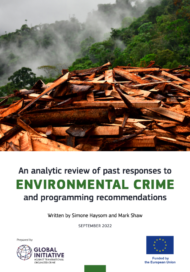Posted on 18 Mar 2024
Digital data is playing an increasingly prominent role in societies around the world, fuelled by expanding internet penetration, the growing reach of social media platforms and the ubiquity of technology in our everyday lives. The same is true in the illicit economy. Technology is being used to serve criminal interests, and this is evolving as criminal actors adapt to evade enforcement strategies. The growing use of data by criminal groups can only be addressed by improving the use of data in the response.
A common criminal use of the internet is the migration of physical illicit environmental markets to sites accessible on the surface web, such as social media and e-commerce platforms. These sites have become the shop windows for often violent, organized criminal groups operating complex supply chains that connect the natural habitats of protected species to the cages, wardrobes and dinner plates of buyers around the world. They are the tip of a highly organized criminal iceberg that is causing harm, suffering and damage to people, animals and ecosystems.
But the abuse of legitimate businesses for illicit purposes goes beyond these platforms. Instant messaging services, courier businesses and money transfer companies provide the communications, logistics and financial services needed to run these global criminal enterprises. As a result, not only is the illicit economy becoming more interconnected, but it is also increasingly depending on the licit economy to function.
This is a worrying trend. As a result of these technology platforms, criminal groups are becoming smaller, more secure and more efficient, with fewer intermediaries, improved communications and greater top-down control of criminal networks. In contrast, enforcement responses have struggled to keep pace, at a time when environmental crime is on the rise globally. Between 2021 and 2023, the average global score for crimes against flora (4.06, +0.18) and fauna (4.83, +0.20) increased faster than the global score for criminality (5.03, +0.16), as measured by the Global Organized Crime Index.
Lack of resources and expertise, and, in some cases, unwillingness to cooperate with global counterparts is undermining investigations into cyber-enabled environmental crimes. Until recently, internet companies had been left to self-regulate the content on their platforms. Although this is changing with legislation passed by the EU and the UK, these laws are predominantly focusing on potential human harms, while their ability to address online environmental crime is unclear.
However, some solutions are available. Data can be used to better understand, detect and disrupt environmental crimes both online and offline. In the online sphere, for example, the criminal exploitation of technology creates an additional point of convergence for illicit environmental flows. The Global Initiative Against Transnational Organized Crime (GI-TOC) has identified three forms of convergence in the illegal wildlife trade: network, hub and broker convergence. There is now a growing case for adding a fourth element to the list – technological convergence.
Unlike the others, technological convergence exists primarily online. The limited number of online platforms and services compared to the high number of organized criminal groups means that many criminal actors converge on one social media platform or money transfer service. There is therefore a potential treasure trove of data across technology platforms that, if properly accessed and analyzed, could be used to provide a better understanding of how these networks operate, where they are based, who is involved and what they trade in, enabling authorities to take enforcement or disruption action.
Such research has already begun. Civil society organizations such as the International Fund for Animal Welfare and TRAFFIC have been involved in internet monitoring to identify instances of online illegal wildlife trade. As part of its ECO-SOLVE programme, the GI-TOC is also developing a global monitoring system that uses artificial intelligence and machine learning to detect illegal posts online.
Although these activities have led to significant successes, they have also highlighted the need for greater cooperation with internet companies, some of which have restricted access to the necessary data. Likewise, shortcomings in data collection, storage and interoperability on the part of the organizations involved mean that the full value of the data has not always been realized. After all, data is only useful if it is used.
Offline, such data can also be used to detect and disrupt environmental crime at key transport hubs. For example, the smuggling of illicit environmental goods across international borders regularly involves illicit flows converging at a customs checkpoint, seaport or airport. However, the detection of protected species presents a significant challenge to customs and border officials, who lack the expertise and capacity to identify tens of thousands of species. To overcome this barrier, some organizations have developed technologies that use DNA data to help identification. But the success of such technology relies on a complex process of collecting DNA samples, encoding them into binary data and making them accessible to third-party researchers.
To reap the benefits of this cache of data, these challenges must be overcome. Failure to do so risks widening the gap between criminal methods and law enforcement responses. Despite the promises of a tech ‘silver bullet’ to combat environmental crime, the reality may be that technological advances further consolidate it as a high-reward and low-risk activity. No one institution, organization or agency can tackle the challenge alone – only with a concerted effort will we have any hope of succeeding. Proper collection, storage, management and sharing of data are essential to ensure an understanding of illicit environmental flows and thus to enable the effective deployment of enforcement resources. The only way to tackle online crime is to be online.
This analysis is part of the ECO-SOLVE series of articles that aims to showcase solutions for monitoring and disrupting illicit environmental flows as well as strengthening international cooperation. ECO-SOLVE is a project implemented by the GI-TOC as part of the European Union’s Global Illicit Flows Programme.
Sign up to the ECO-SOLVE mailing list to receive regular updates about the project.



